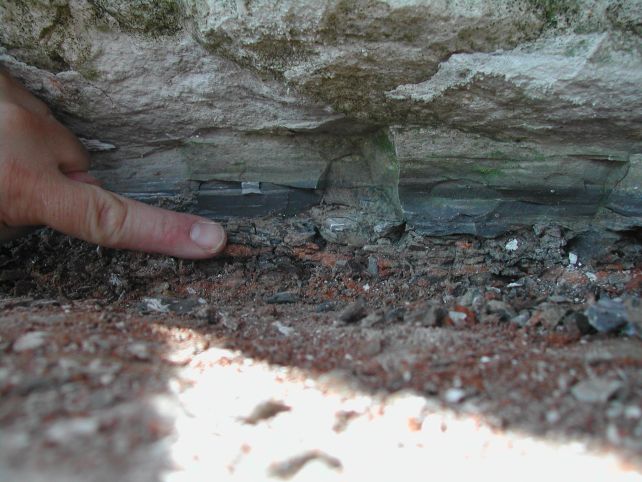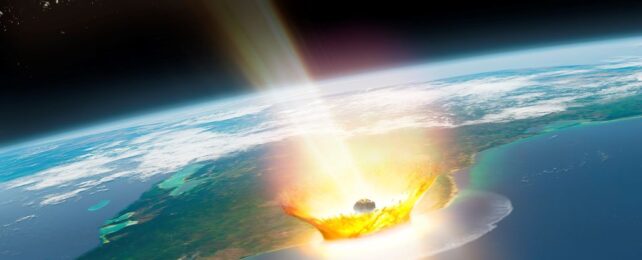A space rock that smacked into Earth 66 million years ago and devastated the ancient life living thereon took a remarkably circuitous route to get here, a new study has found.
The Chicxulub event – the giant impact that ended the reign of non-avian dinosaurs, clearing the way for mammalian life to rise – was triggered by an asteroid from a region of the Solar System out past the orbit of Jupiter, the cold, dark outer limits, far from the Sun's light and warmth.
And an asteroid it was indeed, with the new findings by an international team of researchers ruling out that the object could have been a comet.
This discovery gives us a new understanding of Earth's history, and its interactions with the rest of the Solar System.
Since its infancy, Earth has been repeatedly slammed by large space rocks. It's thought that cometary impacts played a significant role in delivering water to Earth, and we can trace – albeit with varying degrees of difficulty – a number of huge craters scarring the planet after a collision with something large.
Earth has also experienced several mass extinctions, but the only one definitively linked to an impact was the Cretaceous-Paleogene extinction 66 million years ago, responsible for wiping out an estimated 76 percent of all animal species on Earth, including the dinosaurs that didn't go on to have bird descendants.
At the time, an asteroid some 10 kilometers (6 miles) across slammed into what is now the Yucatán Peninsula, leaving behind a colossal crater, and triggering a tsunami of extinctions that changed the world.
Whence originated this deadly rock? We can't exactly rewind time, observe its trajectory through the sky, and trace the arc back to a point in the Solar System. What we can do, however, is look at the layer of sediment preserved in the rock that would have been laid down at the time of the impact, looking for signatures in the minerals that can be matched to known types of space rocks.
In Cretaceous-Paleogene layers, a larger proportion of minerals such as iridium, ruthenium, osmium, rhodium, platinum, and palladium can be found. These platinum-group elements are pretty rare on Earth, especially on the surface. But they're common in meteorites – chunks of rock that fall through Earth's skies from space and slam into the surface.

On the other hand, the Chicxulub impact wasn't the only thing the Earth had going on back then. For nearly a million years around the Cretaceous-Paleogene boundary, a huge volcanic region known as the Deccan Traps was acting out, spewing volcanic material from Earth's underbelly out into the open. This is another possible source of those platinum-group elements observed in the boundary layers.
Led by geochemist Mario Fischer-Gödde of the University of Cologne in Germany, the team wanted to find out, once and for all, whether these minerals were indeed extraterrestrial in origin; and, if so, if they could be traced to a specific type of space rock.
Their studies focused on a mineral called ruthenium, several isotopes of which can be found in the boundary layer. Isotopes are forms of the same element with varying numbers of neutrons, and their ratios to each other in a given sample act as a fingerprint. In terrestrial ruthenium, the isotopes will be found in different proportions from the isotopes in meteorites.
They analyzed the ruthenium from the boundary layer from five different locations: one in Spain, one in Italy, and three from the chalk Cliffs of Stevns in Denmark. They also analyzed ruthenium from five other impacts from the last 541 million years, as well as spherule layers (tiny blobs of meteor sprayed out as the rock melts under the heat of atmospheric entry) dating back to 3.5 to 3.2 billion years ago.
In addition, the researchers analyzed ruthenium from actual meteorites, and checked these results against terrestrial reference samples of ruthenium that formed right here on Earth. This comparison revealed that the ruthenium in the Cretaceous-Paleogene boundary layer was not home-made – it came from space.
And not any old where in space. It was most consistent with a rare type of asteroid called a carbonaceous chondrite, rich in carbon, hailing from the outer Solar System, past the orbit of Jupiter.
The five other impacts were siliceous asteroids, which are found closer to the Sun, and are more common here on Earth. And the ancient spherule layers were, again, carbonaceous, hurled at Earth during the final stages of its mass accumulation.
These results finally reveal the identity of the rock that caused so much havoc. Jupiter is thought to act as something of a barrier to outer Solar System objects, catching asteroids in its orbital path and preventing them from traveling farther in towards the Sun. Some do manage to slip through from time to time, but they normally fall to Earth in smaller chunks than the Chicxulub impactor.
Which raises the question: why was that ancient rock on such a dedicated vendetta against the dinosaurs? Science may never know.
The research has been published in Science.
